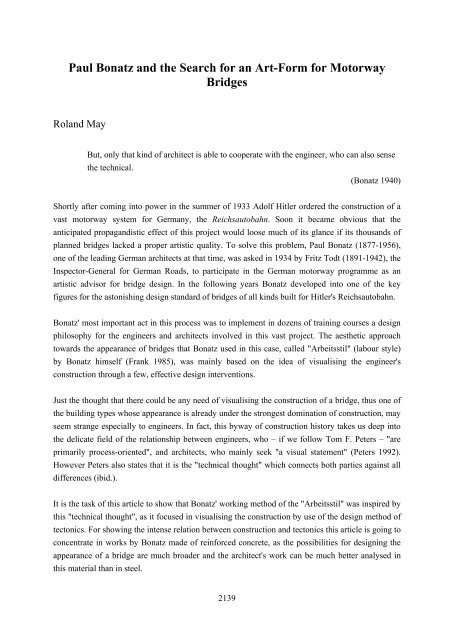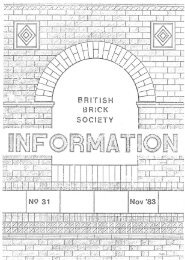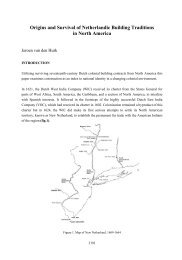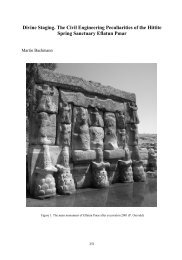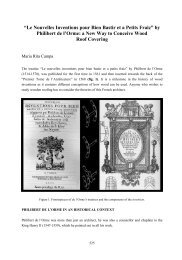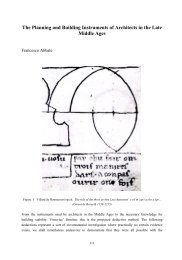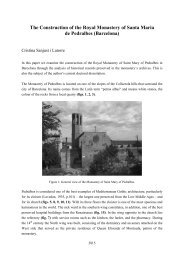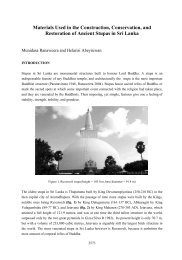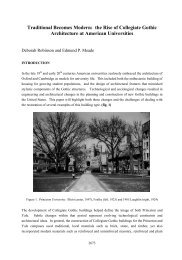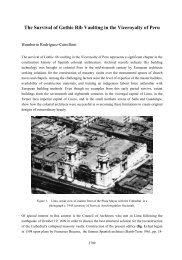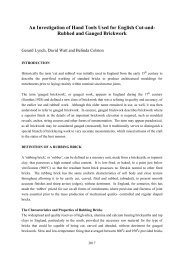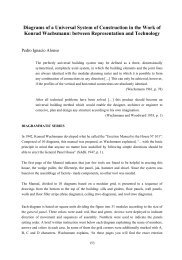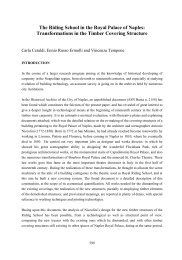Paul Bonatz and the Search for an Art - Department of Architecture
Paul Bonatz and the Search for an Art - Department of Architecture
Paul Bonatz and the Search for an Art - Department of Architecture
You also want an ePaper? Increase the reach of your titles
YUMPU automatically turns print PDFs into web optimized ePapers that Google loves.
<strong>Paul</strong> <strong>Bonatz</strong> <strong><strong>an</strong>d</strong> <strong>the</strong> <strong>Search</strong> <strong>for</strong> <strong>an</strong> <strong>Art</strong>-Form <strong>for</strong> Motorway<br />
Bridges<br />
Rol<strong><strong>an</strong>d</strong> May<br />
But, only that kind <strong>of</strong> architect is able to cooperate with <strong>the</strong> engineer, who c<strong>an</strong> also sense<br />
<strong>the</strong> technical.<br />
(<strong>Bonatz</strong> 1940)<br />
Shortly after coming into power in <strong>the</strong> summer <strong>of</strong> 1933 Adolf Hitler ordered <strong>the</strong> construction <strong>of</strong> a<br />
vast motorway system <strong>for</strong> Germ<strong>an</strong>y, <strong>the</strong> Reichsautobahn. Soon it became obvious that <strong>the</strong><br />
<strong>an</strong>ticipated propag<strong><strong>an</strong>d</strong>istic effect <strong>of</strong> this project would loose much <strong>of</strong> its gl<strong>an</strong>ce if its thous<strong><strong>an</strong>d</strong>s <strong>of</strong><br />
pl<strong>an</strong>ned bridges lacked a proper artistic quality. To solve this problem, <strong>Paul</strong> <strong>Bonatz</strong> (1877-1956),<br />
one <strong>of</strong> <strong>the</strong> leading Germ<strong>an</strong> architects at that time, was asked in 1934 by Fritz Todt (1891-1942), <strong>the</strong><br />
Inspector-General <strong>for</strong> Germ<strong>an</strong> Roads, to participate in <strong>the</strong> Germ<strong>an</strong> motorway programme as <strong>an</strong><br />
artistic advisor <strong>for</strong> bridge design. In <strong>the</strong> following years <strong>Bonatz</strong> developed into one <strong>of</strong> <strong>the</strong> key<br />
figures <strong>for</strong> <strong>the</strong> astonishing design st<strong><strong>an</strong>d</strong>ard <strong>of</strong> bridges <strong>of</strong> all kinds built <strong>for</strong> Hitler's Reichsautobahn.<br />
<strong>Bonatz</strong>' most import<strong>an</strong>t act in this process was to implement in dozens <strong>of</strong> training courses a design<br />
philosophy <strong>for</strong> <strong>the</strong> engineers <strong><strong>an</strong>d</strong> architects involved in this vast project. The aes<strong>the</strong>tic approach<br />
towards <strong>the</strong> appear<strong>an</strong>ce <strong>of</strong> bridges that <strong>Bonatz</strong> used in this case, called "Arbeitsstil" (labour style)<br />
by <strong>Bonatz</strong> himself (Fr<strong>an</strong>k 1985), was mainly based on <strong>the</strong> idea <strong>of</strong> visualising <strong>the</strong> engineer's<br />
construction through a few, effective design interventions.<br />
Just <strong>the</strong> thought that <strong>the</strong>re could be <strong>an</strong>y need <strong>of</strong> visualising <strong>the</strong> construction <strong>of</strong> a bridge, thus one <strong>of</strong><br />
<strong>the</strong> building types whose appear<strong>an</strong>ce is already under <strong>the</strong> strongest domination <strong>of</strong> construction, may<br />
seem str<strong>an</strong>ge especially to engineers. In fact, this byway <strong>of</strong> construction history takes us deep into<br />
<strong>the</strong> delicate field <strong>of</strong> <strong>the</strong> relationship between engineers, who – if we follow Tom F. Peters – "are<br />
primarily process-oriented", <strong><strong>an</strong>d</strong> architects, who mainly seek "a visual statement" (Peters 1992).<br />
However Peters also states that it is <strong>the</strong> "technical thought" which connects both parties against all<br />
differences (ibid.).<br />
It is <strong>the</strong> task <strong>of</strong> this article to show that <strong>Bonatz</strong>' working method <strong>of</strong> <strong>the</strong> "Arbeitsstil" was inspired by<br />
this "technical thought", as it focused in visualising <strong>the</strong> construction by use <strong>of</strong> <strong>the</strong> design method <strong>of</strong><br />
tectonics. For showing <strong>the</strong> intense relation between construction <strong><strong>an</strong>d</strong> tectonics this article is going to<br />
concentrate in works by <strong>Bonatz</strong> made <strong>of</strong> rein<strong>for</strong>ced concrete, as <strong>the</strong> possibilities <strong>for</strong> designing <strong>the</strong><br />
appear<strong>an</strong>ce <strong>of</strong> a bridge are much broader <strong><strong>an</strong>d</strong> <strong>the</strong> architect's work c<strong>an</strong> be much better <strong>an</strong>alysed in<br />
this material th<strong>an</strong> in steel.<br />
2139
SEARCHING APPROPRIATE FORMS FOR ENGINEERING STRUCTURES<br />
After <strong>the</strong> dissolution <strong>of</strong> <strong>the</strong> old ideas about architecture <strong>for</strong>ced by <strong>the</strong> strong impulse <strong>of</strong> <strong>the</strong> Modern<br />
Movement, new paradigms emerged <strong>for</strong> developing <strong><strong>an</strong>d</strong> expressing architecture. Besides <strong>the</strong> idea <strong>of</strong><br />
functionality it was mainly <strong>the</strong> construction that moved into <strong>the</strong> focus <strong>of</strong> <strong>the</strong> conceptual thoughts <strong>of</strong><br />
<strong>the</strong> architects. This reorientation was a consequent reaction to <strong>the</strong> multiple ch<strong>an</strong>ges that befell <strong>the</strong><br />
world in <strong>the</strong> machine age, <strong>an</strong> era that saw <strong>the</strong> breakdown <strong>of</strong> nearly every traditional value but also<br />
<strong>the</strong> triumphal rise <strong>of</strong> a new pr<strong>of</strong>ession: <strong>the</strong> technici<strong>an</strong>. In <strong>the</strong> field <strong>of</strong> building it was <strong>the</strong> civil<br />
engineer who took over <strong>the</strong> role as pacemaker <strong>of</strong> development.<br />
It is one <strong>of</strong> <strong>the</strong> basic doctrines <strong>of</strong> nowadays' architectural history to emphasise <strong>the</strong> role <strong>of</strong> <strong>the</strong><br />
nineteenth-century engineers’ legacy as one <strong>of</strong> <strong>the</strong> most import<strong>an</strong>t sources <strong>for</strong> <strong>the</strong> new paradigm<br />
that was brought into architecture. This argument was already one <strong>of</strong> <strong>the</strong> main aspects in <strong>the</strong> early<br />
historiography <strong>of</strong> Modern <strong>Architecture</strong>, at least since Sigfried Giedion (1888-1968) published his<br />
Book Space, Time <strong><strong>an</strong>d</strong> <strong>Architecture</strong> (Cambridge, Mass., 1941). But Giedion, like most architectural<br />
histori<strong>an</strong>s, seemed to have overseen that engineering also developed fur<strong>the</strong>r on after <strong>the</strong> godfa<strong>the</strong>rs<br />
<strong>of</strong> Modern <strong>Architecture</strong> like Walter Gropius (1883-1969), Ludwig Mies v<strong>an</strong> der Rohe (1886-1969)<br />
or Le Corbusier (1887-1965) had taken over <strong>the</strong> architectural scene (Klotz 1986, 10). Regarding <strong>the</strong><br />
big influence <strong>of</strong> Giedion’s book, one does not have to wonder that <strong>the</strong> intense discussions among<br />
engineers <strong><strong>an</strong>d</strong> architects about <strong>the</strong> aspect <strong>of</strong> engineering structures are a more or less unknown<br />
chapter <strong>of</strong> nowadays’ building history, even if <strong>the</strong>y lasted throughout <strong>the</strong> whole heroic period <strong>of</strong><br />
Modern <strong>Architecture</strong>.<br />
Actually, <strong>the</strong> discussion about <strong>an</strong> adequate <strong>for</strong>mal expression <strong>of</strong> construction already started around<br />
1900, when nei<strong>the</strong>r a pure <strong>for</strong>m following correct statics nor a supplementary beautification by <strong>an</strong><br />
architect were seen <strong>an</strong>y longer as promising paths to <strong>the</strong> future design <strong>of</strong> engineering structures.<br />
One <strong>of</strong> <strong>the</strong> most import<strong>an</strong>t <strong>for</strong>ums <strong>for</strong> <strong>the</strong>se discussions emerged in Germ<strong>an</strong>y in 1907 with <strong>the</strong><br />
Deutscher Werkbund. Founded with <strong>the</strong> intention to improve <strong>the</strong> design <strong>of</strong> all sorts <strong>of</strong> common<br />
artefacts, <strong>the</strong> Werkbund paid special attention to <strong>the</strong> built environment <strong><strong>an</strong>d</strong> thus also on engineering<br />
structures from <strong>the</strong> start.<br />
It was also in Germ<strong>an</strong>y where this discussion got <strong>an</strong>o<strong>the</strong>r import<strong>an</strong>t boost with <strong>the</strong> so-called<br />
"Cologne bridge quarrel" <strong>of</strong> 1913, which developed after <strong>the</strong> competitions <strong>for</strong> a street bridge<br />
between Cologne <strong><strong>an</strong>d</strong> its suburb Deutz on <strong>the</strong> eastern b<strong>an</strong>k <strong>of</strong> <strong>the</strong> Rhine were finished. This conflict<br />
between <strong>the</strong> bridge building comp<strong>an</strong>y Dortmunder Union <strong><strong>an</strong>d</strong> its consulting architect Peter Behrens<br />
(1868-1940) on <strong>the</strong> one h<strong><strong>an</strong>d</strong> <strong><strong>an</strong>d</strong> M.A.N. with its consulting architect Carl Moritz (1863-1944) on<br />
<strong>the</strong> o<strong>the</strong>r h<strong><strong>an</strong>d</strong>, originated from <strong>the</strong> reproach that <strong>the</strong> second-round design <strong>of</strong> <strong>the</strong> latter was a copy <strong>of</strong><br />
<strong>the</strong> first-round design <strong>of</strong> <strong>the</strong> <strong>for</strong>mer. This incident got its import<strong>an</strong>ce by <strong>the</strong> fact that all expert<br />
opinions (no matter if <strong>the</strong>y were delivered by engineers, architects or lawyers) classified both bridge<br />
designs <strong>for</strong> <strong>the</strong> first time <strong>of</strong>ficially as works <strong>of</strong> art because <strong>of</strong> <strong>the</strong>ir delicately refined engineering<br />
structures.<br />
2140
Even if <strong>the</strong> legal proceeding ended in a settlement out <strong>of</strong> court, <strong>the</strong> trial itself was a milestone <strong>for</strong><br />
future bridge design in Germ<strong>an</strong>y. After <strong>the</strong> First World War <strong>an</strong> intense cooperation between<br />
engineers <strong><strong>an</strong>d</strong> architects became <strong>the</strong> st<strong><strong>an</strong>d</strong>ard procedure <strong>for</strong> <strong>the</strong> design <strong>of</strong> import<strong>an</strong>t bridges. Even if<br />
we c<strong>an</strong> find similar cooperations in all import<strong>an</strong>t bridge building nations around 1930, <strong>the</strong> Germ<strong>an</strong><br />
architects' approach to bridge design in this time seems to be <strong>of</strong> signific<strong>an</strong>t difference. While, <strong>for</strong><br />
example, most <strong>of</strong> <strong>the</strong> consulting architects in <strong>the</strong> USA still stuck to <strong>the</strong> late nineteenth-century<br />
principle <strong>of</strong> architectural treatment <strong>of</strong> bridge components, as abutments, piers or towers, <strong>the</strong><br />
Germ<strong>an</strong> architects were normally involved in <strong>the</strong> whole design process <strong><strong>an</strong>d</strong> tried to reach <strong>an</strong><br />
appear<strong>an</strong>ce that corresponded with <strong>the</strong> sober character <strong>of</strong> <strong>an</strong> engineering structure.<br />
Early Designs <strong>for</strong> Engineering Structures by <strong>Paul</strong> <strong>Bonatz</strong><br />
There<strong>for</strong>e, when <strong>Bonatz</strong> started his work on <strong>the</strong> Reichsautobahn in 1934, <strong>the</strong> idea <strong>of</strong> expressing<br />
artistic aims through a design appropriate to <strong>the</strong> engineer's construction itself was already a<br />
widespread attitude among Germ<strong>an</strong> consulting architects. But <strong>the</strong>ir methods still notedly differed<br />
<strong><strong>an</strong>d</strong> did not show a clear concept <strong>for</strong> reaching <strong>the</strong> goal <strong>of</strong> creating a clear <strong><strong>an</strong>d</strong> common l<strong>an</strong>guage <strong>for</strong><br />
<strong>the</strong> appear<strong>an</strong>ce <strong>of</strong> engineering structures. Masses <strong>of</strong> articles <strong><strong>an</strong>d</strong> several books on bridge aes<strong>the</strong>tics<br />
were published, only to show a big confusion about finding <strong>the</strong> right way.<br />
<strong>Bonatz</strong> himself was already quite active in <strong>the</strong> field <strong>of</strong> consulting engineers since <strong>the</strong> middle <strong>of</strong> <strong>the</strong><br />
1920s. Especially his work on <strong>the</strong> barrages <strong>of</strong> <strong>the</strong> Neckar River attracted widespread attention that<br />
also reached <strong>for</strong>eign countries, as it <strong>for</strong>med one <strong>of</strong> <strong>the</strong> essential parts in <strong>an</strong> exhibition about Germ<strong>an</strong><br />
architecture that took place in London's Architectural Association in 1928 (Fig.1). He fur<strong>the</strong>rmore<br />
showed interest in <strong>the</strong> design <strong>of</strong> bridges as he not only cooperated in several competitions with<br />
some <strong>of</strong> <strong>the</strong> most import<strong>an</strong>t Germ<strong>an</strong> bridge building comp<strong>an</strong>ies, but also was involved in <strong>the</strong><br />
erection <strong>of</strong> some chief works <strong>of</strong> Germ<strong>an</strong> bridge engineering <strong>of</strong> those years. One <strong>of</strong> <strong>the</strong>se projects,<br />
<strong>the</strong> bridge over <strong>the</strong> Lech River at Augsburg-Hochzoll, c<strong>an</strong> be seen as a paradigmatic work <strong>for</strong> <strong>the</strong><br />
trend <strong>of</strong> extreme reduction <strong>of</strong> design features in Germ<strong>an</strong> bridge building <strong>of</strong> <strong>the</strong> 1920s.<br />
The supporting construction, erected by <strong>the</strong> comp<strong>an</strong>y Wayss & Freytag after <strong>the</strong> ideas <strong>of</strong> <strong>the</strong><br />
engineer Oskar Muy (active around 1913-64), was <strong>for</strong>med by four hollow-box three-hinged arch<br />
ribs in rein<strong>for</strong>ced concrete. The arch ribs, sp<strong>an</strong>ning more th<strong>an</strong> 80 metres, showed <strong>an</strong> unusual slight<br />
rise <strong>of</strong> only 8.15 metres, making <strong>the</strong> bridge one <strong>of</strong> <strong>the</strong> outst<strong><strong>an</strong>d</strong>ing examples <strong>of</strong> its time. But, besides<br />
<strong>the</strong> obvious fact <strong>of</strong> giving <strong>the</strong> impression <strong>of</strong> <strong>an</strong> arch bridge, <strong>the</strong> aspect <strong>of</strong> <strong>the</strong> building did not give<br />
<strong>an</strong>y hints about <strong>the</strong> used construction. To get a slight idea <strong>of</strong> <strong>the</strong> structural principle only was<br />
possible under <strong>the</strong> s<strong>of</strong>fit, as here <strong>the</strong> several ribs that <strong>for</strong>med <strong>the</strong> arch were partly visible. The rest <strong>of</strong><br />
<strong>the</strong> building instead seemed like a big solid sculpture where some gi<strong>an</strong>t craftsm<strong>an</strong> millcutted a few<br />
deepenings <strong>for</strong> making <strong>the</strong> passage possible. Thus <strong>the</strong> thought <strong>of</strong> creating a figure appropriate to <strong>the</strong><br />
engineer's construction in this bridge was clearly dominated by <strong>the</strong> idea <strong>of</strong> pureness in <strong>for</strong>m but not<br />
<strong>of</strong> explaining <strong>the</strong> construction (Fig.2).<br />
2141
Figure 1. <strong>Paul</strong> <strong>Bonatz</strong> (architect), Neckar barrage at Horkheim, 1927-29 (Graubner 1931, p. 24)<br />
Figure 2. <strong>Paul</strong> <strong>Bonatz</strong> (architect), Lechbrücke Augsburg-Hochzoll, 1927/28 (Mörsch 1933, p. 381)<br />
RETHINKING THE MOTORWAY OVERPASS<br />
In <strong>the</strong> bridge over <strong>the</strong> Lech River <strong>Bonatz</strong> shows a m<strong>an</strong>ner that is typical <strong>for</strong> <strong>the</strong> tendency in bridge<br />
design in Germ<strong>an</strong>y at <strong>the</strong> time around 1930 (<strong><strong>an</strong>d</strong> that leads in steel bridge design to <strong>the</strong> clear<br />
preference <strong>for</strong> plate girders over trusses). But this very sculptural approach did not seem to be <strong>an</strong><br />
adequate working method <strong>for</strong> <strong>the</strong> mission that awaited <strong>Bonatz</strong> a few years later, when he was asked<br />
by Fritz Todt to become his consulting architect <strong>for</strong> <strong>the</strong> bridges <strong>of</strong> <strong>the</strong> Reichsautobahn.<br />
Todt’s reason <strong>for</strong> employing <strong>an</strong> architect was based on a deep frustration over <strong>the</strong> appear<strong>an</strong>ce <strong>of</strong> <strong>the</strong><br />
overpasses on <strong>the</strong> first section <strong>of</strong> <strong>the</strong> Reichsautobahn between Fr<strong>an</strong>kfurt <strong><strong>an</strong>d</strong> Darmstadt. These<br />
bridges had to be commenced in a hustle, as Hitler ordered <strong>the</strong> works on <strong>the</strong> motorway project to be<br />
started only a few months after he had come to power. So <strong>the</strong> engineers <strong>of</strong> <strong>the</strong> main construction<br />
2142
supervision <strong>of</strong>fice (OBK) in Fr<strong>an</strong>kfurt, all <strong>of</strong> <strong>the</strong>m coming originally from <strong>the</strong> Germ<strong>an</strong> railway<br />
authority, designed <strong>the</strong> overpasses toge<strong>the</strong>r with local firms not only in different systems but also in<br />
<strong>the</strong> same simple m<strong>an</strong>ner as <strong>the</strong>y had done be<strong>for</strong>e with minor underpasses on <strong>the</strong> railway lines. In<br />
fact, <strong>the</strong> overpasses, sp<strong>an</strong>ning only over a moderate dist<strong>an</strong>ce, were not spectacular constructions at<br />
all. But <strong>for</strong> Todt it soon was obvious that <strong>the</strong>y would play a key role <strong>for</strong> <strong>the</strong> perception <strong>of</strong> <strong>the</strong> whole<br />
motorway project as <strong>the</strong> concept <strong>of</strong> grade separation called <strong>for</strong> such bridges on <strong>an</strong> average interval<br />
<strong>of</strong> 800 metres. In addition, <strong>the</strong> overpasses were <strong>the</strong> only built structures that could be seen by <strong>the</strong><br />
drivers as <strong>the</strong> bigger, much more ambitious bridges were hidden under <strong>the</strong> road’s surface.<br />
<strong>Bonatz</strong>’ first task was to write <strong>an</strong> article <strong>for</strong> <strong>the</strong> first issue <strong>of</strong> Todt’s freshly founded magazine “Die<br />
Strasse” (<strong>the</strong> road) that was pl<strong>an</strong>ned to become <strong>the</strong> propag<strong><strong>an</strong>d</strong>istic centrepiece <strong>of</strong> <strong>the</strong> motorway<br />
project. In this article <strong>Bonatz</strong> presented three basic principles <strong>for</strong> <strong>the</strong> overpasses:<br />
[…] as little remarkable as possible<br />
as few mass as possible <strong><strong>an</strong>d</strong><br />
as much <strong>for</strong>ward sight <strong><strong>an</strong>d</strong> field <strong>of</strong> view as possible.<br />
(<strong>Bonatz</strong> 1934, p. 14)<br />
Thus <strong>Bonatz</strong> here dem<strong><strong>an</strong>d</strong>ed <strong>the</strong> realisation <strong>of</strong> a constructionally optimised aes<strong>the</strong>tics <strong>of</strong> "growing<br />
boldness <strong><strong>an</strong>d</strong> airiness" (<strong>Bonatz</strong> 1934, p. 15), like he had established it already in several bridge<br />
designs short be<strong>for</strong>e, as, <strong>for</strong> inst<strong>an</strong>ce, in <strong>the</strong> Bridge over <strong>the</strong> Neckar c<strong>an</strong>al harbour in Heilbronn<br />
(Fig.3).<br />
Figure 3. <strong>Paul</strong> <strong>Bonatz</strong> (architect), K<strong>an</strong>alhafenbrücke Heilbronn, 1930-32 (Mörsch 1933, p. 516)<br />
2143
In order to avoid <strong>the</strong> cacophony <strong>of</strong> different overpass types, as it had been produced on <strong>the</strong> first<br />
section <strong>of</strong> <strong>the</strong> Reichsautobahn, <strong>Bonatz</strong> emphasised also <strong>the</strong> import<strong>an</strong>ce <strong>of</strong> st<strong><strong>an</strong>d</strong>ardisation <strong>for</strong> <strong>the</strong><br />
overpasses, in order to achieve "a series-like toge<strong>the</strong>rness" in <strong>the</strong> different sections (<strong>Bonatz</strong> 1934,<br />
14). But, besides all engineer-like rationality, a reference to regional aspects remained <strong>of</strong> great<br />
import<strong>an</strong>ce to him:<br />
By no me<strong>an</strong>s will <strong>the</strong> same type be used uni<strong>for</strong>mly in <strong>the</strong> whole <strong>of</strong> Germ<strong>an</strong>y. In <strong>the</strong><br />
mountains <strong>the</strong>se bridges will look different th<strong>an</strong> in <strong>the</strong> plain. On rock <strong>the</strong>y will have<br />
<strong>an</strong>o<strong>the</strong>r expression th<strong>an</strong> on s<strong><strong>an</strong>d</strong>.<br />
(<strong>Bonatz</strong> 1934, p. 14)<br />
In <strong>the</strong> following part <strong>Bonatz</strong> discussed basic design possibilities <strong>for</strong> overpasses, remarking that <strong>the</strong><br />
"accentuation <strong>of</strong> <strong>the</strong> functions" <strong><strong>an</strong>d</strong> thus <strong>the</strong> illustration <strong>of</strong> <strong>the</strong> "struggle <strong>of</strong> <strong>the</strong> <strong>for</strong>ces" represented<br />
<strong>for</strong> him <strong>the</strong> basis in <strong>the</strong> design <strong>of</strong> engineering structures (<strong>Bonatz</strong> 1934, p. 15). <strong>Bonatz</strong> also paid<br />
certain attention to <strong>the</strong> central support that was reasonable <strong>for</strong> girders in rein<strong>for</strong>ced concrete due to<br />
<strong>the</strong> 5 metres broad centre strip. Although this element established pretty uncommon bridges with<br />
two openings, <strong>Bonatz</strong> pointed out that <strong>the</strong>rein could also be <strong>the</strong> possibility to develop a new bridge<br />
<strong>for</strong>m. There<strong>for</strong>e <strong>Bonatz</strong> presented not only four basic <strong>for</strong>ms <strong>of</strong> overpasses, but afterwards also<br />
discussed by me<strong>an</strong>s <strong>of</strong> five examples some good <strong><strong>an</strong>d</strong> bad solutions <strong>for</strong> <strong>the</strong> junction <strong>of</strong> <strong>the</strong> central<br />
support with <strong>the</strong> superstructure.<br />
His four basic overpass types consisted <strong>of</strong> two examples with clearly pronounced abutments that<br />
were slightly set <strong>of</strong>f against <strong>the</strong> edge <strong>of</strong> <strong>the</strong> roadway. One <strong>of</strong> <strong>the</strong>m showed two-hinged frames with<br />
hinged supports in <strong>the</strong> centre (A), <strong>the</strong> o<strong>the</strong>r one a beam that was firmly fixed above <strong>the</strong> clamped<br />
central pillar (B). The o<strong>the</strong>r two basic types came with four openings. One being a continuous beam<br />
on three clamped supporting piers (C), <strong>the</strong> o<strong>the</strong>r one a rigid frame construction that was articulated<br />
at <strong>the</strong> bases (Fig.4). The fundamental characteristics <strong>of</strong> all four schemes were railings <strong><strong>an</strong>d</strong><br />
protruded sidewalks that reached also over <strong>the</strong> abutments, a slightly curved alignment in <strong>the</strong><br />
longitudinal section <strong><strong>an</strong>d</strong> a treatment <strong>of</strong> <strong>the</strong> supports that was appropriate to each bridge type, since<br />
this was <strong>for</strong> <strong>Bonatz</strong> "<strong>of</strong> crucial import<strong>an</strong>ce" (<strong>Bonatz</strong> 1934, p. 18)<br />
Four positive examples <strong>for</strong> <strong>the</strong> design <strong>of</strong> <strong>the</strong> central supports (E, F, G, H) demonstrated in<br />
comparison to a counter-example (J) a fur<strong>the</strong>r import<strong>an</strong>t work method <strong>of</strong> <strong>Bonatz</strong> (Fig.5). It was <strong>the</strong><br />
intensification <strong>of</strong> already existing contrasts between <strong>the</strong> structural elements "to give <strong>an</strong> <strong>an</strong>imated<br />
expression to <strong>the</strong> tr<strong>an</strong>sition from support to load." (<strong>Bonatz</strong> 1934, p. 18)<br />
As we c<strong>an</strong> learn from <strong>the</strong> third issue <strong>of</strong> Die Strasse, it seems that <strong>the</strong> article provoked some<br />
expressions <strong>of</strong> displeasure from <strong>the</strong> engineers, most <strong>of</strong> <strong>the</strong>m referring particularly to a somewhat<br />
diffused description <strong>of</strong> <strong>the</strong> static system <strong>of</strong> <strong>the</strong> example A. Since such criticism could have led to<br />
subst<strong>an</strong>tial doubts about <strong>the</strong> expert knowledge <strong>of</strong> <strong>the</strong> designated supreme bridge designer <strong>of</strong> <strong>the</strong><br />
2144
Reichsautobahn, Todt necessarily had to respond to it. His reaction was extremely smart, because<br />
Die Strasse published a statement <strong>of</strong> Emil Mörsch (1872-1950), who was <strong>an</strong> unquestioned authority<br />
in <strong>the</strong> area <strong>of</strong> rein<strong>for</strong>ced concrete in this time in Germ<strong>an</strong>y. Mörsch first stressed his deep knowledge<br />
<strong>of</strong> <strong>the</strong> objectionable project by mentioning that it was compiled by <strong>the</strong> comp<strong>an</strong>y Wayss & Freytag<br />
under his supervision, in order to defend <strong>the</strong>reupon <strong>Bonatz</strong> in all points <strong>of</strong> attack (Mörsch 1934).<br />
Figure 4. <strong>Paul</strong> <strong>Bonatz</strong>, Basic types <strong>for</strong> motorway overpasses, 1934 (<strong>Bonatz</strong> 1934, p. 15)<br />
Figure 5. <strong>Paul</strong> <strong>Bonatz</strong>, Basic types <strong>for</strong> junctions between beams <strong><strong>an</strong>d</strong> supports, 1934<br />
(<strong>Bonatz</strong> 1934, p. 16-7)<br />
2145
Being under <strong>the</strong> protection <strong>of</strong> Mörsch in a technical view me<strong>an</strong>t that no fur<strong>the</strong>r criticism about<br />
<strong>Bonatz</strong>’ <strong>the</strong>ses arose. In fact, <strong>Bonatz</strong>’ thoughts even were endorsed by Karl Schaechterle (1879-<br />
1971) <strong>of</strong> Stuttgart, <strong>the</strong> engineer who would become <strong>the</strong> central figure <strong>for</strong> bridge engineering <strong>of</strong> <strong>the</strong><br />
Reichsautobahn in <strong>the</strong> following years. Toge<strong>the</strong>r with his young assist<strong>an</strong>t Fritz Leonhardt (1909-<br />
1999), Schaechterle fully backed <strong>Bonatz</strong>’ <strong>the</strong>ses in <strong>an</strong>o<strong>the</strong>r article about motorway overpass design,<br />
which just a few months later was also published in Die Strasse (Schaechterle <strong><strong>an</strong>d</strong> Leonhardt 1934).<br />
The Design <strong>of</strong> Overpasses on O<strong>the</strong>r Motorways<br />
For underst<strong><strong>an</strong>d</strong>ing <strong>the</strong> relev<strong>an</strong>ce <strong>of</strong> <strong>Bonatz</strong>’ approach <strong>of</strong> using <strong>the</strong> visualisation <strong>of</strong> <strong>the</strong> construction<br />
as design principle <strong>for</strong> overpasses it is necessary to have a short look to <strong>the</strong> <strong>for</strong>ms <strong>of</strong> edifices <strong>of</strong> this<br />
type in Italy <strong><strong>an</strong>d</strong> <strong>the</strong> USA, <strong>the</strong> only two o<strong>the</strong>r countries that also possessed motorway-like roads at<br />
<strong>the</strong> beginning <strong>of</strong> <strong>the</strong> 1930s. The Autostrada dei Laghi (1923-25), built <strong>for</strong> connecting Mil<strong>an</strong> with<br />
<strong>the</strong> lakes in nor<strong>the</strong>rn Italy, was <strong>the</strong> first extensive project in Europe <strong>of</strong> <strong>an</strong> automobile road that<br />
showed grade separation over <strong>the</strong> whole dist<strong>an</strong>ce. Even if its overpasses, due to a road width <strong>of</strong> only<br />
8 metres, did not need <strong>an</strong>y supporting structures in <strong>the</strong>ir centre, we still c<strong>an</strong> compare <strong>the</strong> different<br />
design philosophies <strong>of</strong> this overpasses <strong><strong>an</strong>d</strong> <strong>the</strong> proposals <strong>of</strong> <strong>Bonatz</strong> <strong>for</strong> <strong>the</strong> Reichsautobahn. Framed<br />
by wing walls nearly rect<strong>an</strong>gular to <strong>the</strong> surpassing road, <strong>the</strong> sparsely subdivided structure in<br />
rein<strong>for</strong>ced concrete reminds us <strong>of</strong> <strong>the</strong> reduced <strong>for</strong>ms <strong>of</strong> <strong>Bonatz</strong>’ Lech Bridge, though its<br />
unharmonious expression c<strong>an</strong>’t be called artistic at all (Fig.6).<br />
Figure 6. Overpass on <strong>the</strong> Autostrada dei Laghi, ca. 1924 (Livini 1984, p. 52)<br />
Clearly designed with more ambition were <strong>the</strong> st<strong><strong>an</strong>d</strong>ard overpasses <strong>for</strong> <strong>the</strong> motorway between<br />
Mil<strong>an</strong> <strong><strong>an</strong>d</strong> Turin (1929-32). The bridges were now showing two more openings <strong>for</strong> giving a better<br />
<strong>for</strong>ward view <strong><strong>an</strong>d</strong> possessed a more sophisticated parapet. But, like <strong>the</strong> <strong>for</strong>mer example, <strong>the</strong>se<br />
bridges, besides <strong>the</strong>ir ra<strong>the</strong>r rough appear<strong>an</strong>ce, did not show <strong>an</strong>y artistic way <strong>of</strong> dealing with <strong>the</strong><br />
construction. Especially <strong>the</strong> haunched junction between T-beam <strong><strong>an</strong>d</strong> support did not impart a clear<br />
idea <strong>of</strong> <strong>the</strong> static system <strong><strong>an</strong>d</strong> matched almost with <strong>Bonatz</strong>’ counter-example J (Fig.7).<br />
2146
Figure 7. St<strong><strong>an</strong>d</strong>ard type <strong>of</strong> overpasses on <strong>the</strong> Autostrada Mil<strong>an</strong>o-Torino, ca. 1929 (Livini 1984, p. 107)<br />
Totally different from <strong>the</strong> pragmatic functionalism <strong>of</strong> <strong>the</strong> Itali<strong>an</strong> overpasses were <strong>the</strong> bridges on <strong>the</strong><br />
Americ<strong>an</strong> motorway-like roads <strong>of</strong> this time. One <strong>of</strong> <strong>the</strong> most prominent examples is <strong>the</strong> Merritt<br />
Parkway in Connecticut, which was begun in <strong>the</strong> same year when <strong>Bonatz</strong> published his article <strong><strong>an</strong>d</strong><br />
got finished in 1940. Similar to <strong>the</strong> Reichsautobahn, <strong>the</strong> Parkways were not only pl<strong>an</strong>ned as<br />
expedient traffic systems but also as elements to enrich both <strong>the</strong> pleasure <strong>for</strong> <strong>the</strong> surrounding<br />
scenery <strong><strong>an</strong>d</strong> <strong>the</strong> l<strong><strong>an</strong>d</strong>scape itself. Projected to become a model <strong>for</strong> <strong>the</strong> highway <strong>of</strong> <strong>the</strong> future, even<br />
<strong>the</strong> layout <strong>of</strong> <strong>the</strong> Merritt Parkway with separated two-l<strong>an</strong>e roadways <strong>for</strong> both directions was nearly<br />
<strong>the</strong> same as in Germ<strong>an</strong>y. The only import<strong>an</strong>t difference was that <strong>the</strong> 6.80 metres wide centre strip<br />
was narrowed to 0.40 metres in <strong>the</strong> r<strong>an</strong>ge <strong>of</strong> <strong>the</strong> overpasses to avoid a centre support. Never<strong>the</strong>less,<br />
<strong>the</strong> role <strong>of</strong> <strong>the</strong> bridges <strong>of</strong> <strong>the</strong> Merritt Parkway also was seen to be import<strong>an</strong>t <strong>for</strong> <strong>the</strong> perception <strong>of</strong> <strong>the</strong><br />
whole project <strong><strong>an</strong>d</strong> thus <strong>the</strong>y were designed in cooperation with <strong>an</strong> architect, George L.<br />
Dunkelberger (1891-1960) (Fig.8).<br />
Figure 8. George L. Dunkelberger (architect), Overpasses on Merritt Parkway, ca. 1937 (Sumner 1938, 397-8)<br />
Compared to <strong>Bonatz</strong>’ drafts, Dunkelberger’s different attitude towards <strong>the</strong> design <strong>of</strong> engineering<br />
structures is more th<strong>an</strong> obvious. In spite <strong>of</strong> <strong>the</strong> use <strong>of</strong> merely st<strong><strong>an</strong>d</strong>ardised rigid frame constructions,<br />
2147
each <strong>of</strong> <strong>the</strong> 70 overpasses <strong>of</strong> <strong>the</strong> Merritt Parkway got its own, extremely elaborated appear<strong>an</strong>ce. By<br />
doing so, Dunkelberger’s designs did not care about <strong>the</strong> construction <strong>of</strong> <strong>the</strong> edifices at all. There<strong>for</strong>e<br />
his work, though showing some up-to-date <strong>Art</strong> Deco <strong>for</strong>ms in some <strong>of</strong> <strong>the</strong> overpasses, still belonged<br />
to <strong>the</strong> tradition <strong>of</strong> <strong>the</strong> nineteenth century, when <strong>the</strong> architectural treatment <strong>of</strong> bridges was seen to be<br />
totally independent from <strong>the</strong> engineer’s structure.<br />
Looking <strong>for</strong> Solutions <strong>for</strong> <strong>the</strong> Reichsautobahn Overpasses<br />
Coming back to <strong>the</strong> work <strong>of</strong> <strong>Paul</strong> <strong>Bonatz</strong>, we discover that also in Germ<strong>an</strong>y things did not develop<br />
immediately as well as expected <strong><strong>an</strong>d</strong> Todt had to turn to <strong>Bonatz</strong> again. After a visit to <strong>the</strong> nearly<br />
completed section between Fr<strong>an</strong>kfurt <strong><strong>an</strong>d</strong> Darmstadt Todt wrote to <strong>Bonatz</strong> at <strong>the</strong> beginning <strong>of</strong> 1935<br />
that he was "shaken to <strong>the</strong> core by <strong>the</strong> bad architectural appear<strong>an</strong>ce <strong>of</strong> <strong>the</strong> numerous bridges, which<br />
now are sp<strong>an</strong>ning over <strong>the</strong> roadway" (BA Bln, R 4601/1489) (Fig.9). In order to finally get rid <strong>of</strong><br />
<strong>the</strong> problem with <strong>the</strong> overpasses, Todt suggested that <strong>Bonatz</strong> should provide a report about <strong>the</strong><br />
buildings <strong>of</strong> this section, which could serve as future assist<strong>an</strong>ce <strong>for</strong> <strong>the</strong> OBK:<br />
With your excellent way to treat <strong>the</strong> things, it surely will be possible to help essentially<br />
<strong><strong>an</strong>d</strong> not to raise at all a feeling <strong>of</strong> <strong>an</strong>noy<strong>an</strong>ce about <strong>the</strong> criticism.<br />
(ibid.)<br />
In fact <strong>the</strong> <strong>for</strong>mer civil engineer Todt seemed to be very <strong>an</strong>xious about <strong>the</strong> reactions <strong>of</strong> his engineers<br />
towards criticism from <strong>an</strong> architect, even if <strong>the</strong> situation <strong>of</strong> <strong>the</strong> overpasses was not everywhere as<br />
devastating as in Fr<strong>an</strong>kfurt. In particular <strong>the</strong> bridge department <strong>of</strong> <strong>the</strong> OBK in Stuttgart under <strong>the</strong><br />
direction <strong>of</strong> Karl Schaechterle already had to <strong>of</strong>fer some satisfying solutions <strong>for</strong> overpass structures.<br />
Especially Fritz Leonhardt’s experimental steel constructions, like his overpass at Jungingen,<br />
achieved with <strong>the</strong>ir light decks in a cellular construction (that later would be known as orthotropic<br />
slab) a slimness that so far was hardly known (Leonhardt 1998, pp. 54-5).<br />
As <strong>the</strong> solutions <strong>for</strong> steel bridges by <strong>the</strong> OBK Stuttgart were also seen by <strong>Bonatz</strong> to be absolutely<br />
satisfying (HStA Wi 485/396, p. 8), he only concentrated in overpasses made in rein<strong>for</strong>ced<br />
concrete. But Todt still seemed to be insecure about <strong>the</strong> reaction <strong>of</strong> <strong>the</strong> engineers in <strong>the</strong> different<br />
OBK. Even if <strong>Bonatz</strong>’ report was only delivered in 20 copies at <strong>the</strong> beginning <strong>of</strong> April 1935, Todt<br />
tried to point out in his <strong>for</strong>eword that it was not <strong>the</strong> goal <strong>of</strong> this expertise to show <strong>the</strong> engineers a<br />
sole path <strong>for</strong> bridge design:<br />
I know that two architects rarely are <strong>of</strong> <strong>the</strong> same opinion. It is <strong>the</strong> objective <strong>of</strong> this<br />
expertise, by me<strong>an</strong>s <strong>of</strong> a consistent point <strong>of</strong> view, to give <strong>an</strong> accomplished <strong>for</strong>m also to<br />
<strong>the</strong> subordinated buildings. The expertise regards <strong>the</strong> suggested solution not as <strong>the</strong> only<br />
one, but as one <strong>of</strong> <strong>the</strong> possible good solutions.<br />
(HstA Wi 485/396, p. 51)<br />
2148
In <strong>the</strong> following we will take a look to <strong>the</strong> contents <strong>of</strong> this "Report about <strong>the</strong> overpasses over <strong>the</strong><br />
Reichsautobahn on <strong>the</strong> section Fr<strong>an</strong>kfurt (Main) – Darmstadt" (HStA Wi 485/396, pp. 7-28), <strong>of</strong><br />
which <strong>the</strong> architect Friedrich Tamms (1904-1980), who became also involved in <strong>the</strong><br />
Reichsautobahn project in 1935, reported that <strong>Bonatz</strong> <strong>the</strong>rein "[w]ith <strong>the</strong> experiences <strong>of</strong> a skilled<br />
university teacher [... ] touched <strong>the</strong> sore spots, not searching <strong>for</strong> <strong>the</strong> outst<strong><strong>an</strong>d</strong>ing, but <strong>the</strong> general"<br />
(Tamms 1942, p. 219).<br />
<strong>Bonatz</strong> pointed out at <strong>the</strong> beginning that due to <strong>the</strong> time pressure during <strong>the</strong> start phase <strong>of</strong> <strong>the</strong><br />
motorway project, it was totally normal that <strong>the</strong> first overpasses had to be a sort <strong>of</strong> experiments. The<br />
bridges on this section showed:<br />
Composite constructions, rigid frames in rein<strong>for</strong>ced concrete, girders in rein<strong>for</strong>ced<br />
concrete with <strong><strong>an</strong>d</strong> without haunches, plain <strong><strong>an</strong>d</strong> pr<strong>of</strong>iled, with clamped piers <strong><strong>an</strong>d</strong> with<br />
hinged pillars, through bridges, bridges with closed <strong><strong>an</strong>d</strong> opened parapet.<br />
(HStA Wi 485/396, p. 8)<br />
Figure 9. Overpasses Provinzialstrasse L<strong>an</strong>gen–Mörfelden (left), 1933/34, <strong><strong>an</strong>d</strong> Alte Mainzerstrasse (right),<br />
1933, on <strong>the</strong> Reichsautobahn section Fr<strong>an</strong>kfurt–Darmstadt (Leidner 1934, p. 354-5)<br />
Consequently <strong>Bonatz</strong>, different from Dunkelberger’s method in <strong>the</strong> Merritt Parkway, saw his task in<br />
choosing <strong>the</strong> characteristic types from this multitude as in his opinion <strong>the</strong> same conditions should<br />
naturally lead to <strong>the</strong> same <strong>for</strong>ms <strong><strong>an</strong>d</strong> <strong>the</strong>n to develop <strong>the</strong>m towards a better expression.<br />
Subsequently he started with <strong>an</strong> <strong>an</strong>alysis <strong>of</strong> 12 different overpasses that had been built on <strong>the</strong> 21.3<br />
km long section. Out <strong>of</strong> <strong>the</strong>se cases we will take a look at <strong>the</strong> overpass Alte Mainzerstrasse close to<br />
Fr<strong>an</strong>kfurt in km 0.316 as <strong>Bonatz</strong>’ work method c<strong>an</strong> be shown very clear in this example.<br />
The actually built double-sp<strong>an</strong> beam bridge was <strong>for</strong>med by a composite construction made <strong>of</strong> Peiner<br />
girders enclosed in concrete <strong><strong>an</strong>d</strong> crossed <strong>the</strong> motorway with <strong>an</strong> <strong>an</strong>gle <strong>of</strong> 77 degrees. Its sidewalk’s<br />
s<strong>of</strong>fits were lifted 0.30 metres against <strong>the</strong> main deck <strong><strong>an</strong>d</strong> coronated by a massive parapet (Figs.9<br />
<strong><strong>an</strong>d</strong> 10). While <strong>the</strong> continuous superstructure seemed to melt toge<strong>the</strong>r with <strong>the</strong> strong central pier, it<br />
was positioned at both sides on bearing seats that were only expressed by short joints at <strong>the</strong><br />
junctions.<br />
2149
<strong>Bonatz</strong>’ suggestions <strong>for</strong> improvement <strong>of</strong> <strong>the</strong> edifice respected <strong>the</strong> original construction but totally<br />
ch<strong>an</strong>ged <strong>the</strong> appear<strong>an</strong>ce <strong>of</strong> <strong>the</strong> bridge (Fig.10). Like a surgeon, he took out <strong>the</strong> single elements <strong>of</strong><br />
<strong>the</strong> overpass at <strong>the</strong>ir seams <strong><strong>an</strong>d</strong> put <strong>the</strong>m toge<strong>the</strong>r again in such a way that every element’s function<br />
was visible. A light iron railing <strong><strong>an</strong>d</strong> <strong>the</strong> c<strong>an</strong>tilevered sidewalk marked <strong>the</strong> position <strong>of</strong> <strong>the</strong> deck, <strong>the</strong><br />
bearing seats <strong><strong>an</strong>d</strong> <strong>the</strong> pier were clearly contrasted to <strong>the</strong> horizontality <strong>of</strong> <strong>the</strong> loading beam.<br />
Figure 10. <strong>Paul</strong> <strong>Bonatz</strong>, Suggested improvement (left) <strong><strong>an</strong>d</strong> actual state (right) <strong>of</strong> <strong>the</strong> overpass Alte<br />
Mainzerstrasse on <strong>the</strong> Reichsautobahn near Fr<strong>an</strong>kfurt, 1935 (HStA Wi, 485/396, p. 34)<br />
Subsequent to <strong>the</strong> completion <strong>of</strong> <strong>the</strong> expertise, <strong>Bonatz</strong> did not only publish <strong>an</strong>o<strong>the</strong>r article about <strong>the</strong><br />
o<strong>the</strong>r subordinated structures <strong>of</strong> <strong>the</strong> motorway, <strong>the</strong> underpasses (<strong>Bonatz</strong> 1935), but also started to<br />
org<strong>an</strong>ise extensive training courses <strong>for</strong> all 15 OBK toge<strong>the</strong>r with Karl Schaechterle <strong><strong>an</strong>d</strong> Friedrich<br />
Tamms. Different from his first attempts, <strong>Bonatz</strong>’ ef<strong>for</strong>ts now showed much more success as is<br />
illustrated here by two examples <strong>of</strong> average subordinated bridges out <strong>of</strong> <strong>the</strong> region <strong>of</strong> Dresden from<br />
<strong>the</strong> following years (Fig.11). Combined <strong><strong>an</strong>d</strong> contrasted with facings out <strong>of</strong> regional stones all main<br />
constructive elements were expressed sharply in both edifices. Though mainly st<strong><strong>an</strong>d</strong>ardised, <strong>the</strong><br />
bridges differed in <strong>the</strong>ir details (here <strong>for</strong> example <strong>the</strong> junctions between girder <strong><strong>an</strong>d</strong> abutment). With<br />
a great r<strong>an</strong>ge <strong>of</strong> vari<strong>an</strong>ce in <strong>the</strong> different sections <strong>of</strong> <strong>the</strong> Reichsautobahn nearly all bridges now<br />
followed <strong>Bonatz</strong>’ ideas <strong>for</strong> improving <strong>the</strong> visibility <strong>of</strong> <strong>the</strong> construction in <strong>the</strong> sense <strong>of</strong> what he<br />
pointed out 15 years later in his memoirs:<br />
"By beauty today we underst<strong><strong>an</strong>d</strong> no more <strong>the</strong> attached, but <strong>the</strong> purity <strong><strong>an</strong>d</strong> intelligibility <strong>of</strong><br />
<strong>for</strong>m, <strong>the</strong> obviousness <strong>of</strong> <strong>the</strong> play <strong>of</strong> <strong>for</strong>ces, <strong>the</strong> differentiation <strong>of</strong> heavy <strong><strong>an</strong>d</strong> light, <strong>of</strong><br />
loading or hovering, in brief <strong>the</strong> expressiveness."<br />
(<strong>Bonatz</strong> 1950, p. 165)<br />
2150
Figure 11. Solutions <strong>for</strong> <strong>an</strong> overpass <strong><strong>an</strong>d</strong> <strong>an</strong> underpass from <strong>the</strong> OBK Dresden, ca. 1938<br />
(Buschm<strong>an</strong>n 1939, p. 25)<br />
TECTONICS – THE ARTISTIC EXPRESSION OF CONSTRUCTION<br />
The design technique used by <strong>Bonatz</strong> in his work <strong>for</strong> <strong>the</strong> bridges <strong>of</strong> <strong>the</strong> Reichsautobahn shows clear<br />
similarities with contemporary developments in Modern <strong>Architecture</strong>, where, different from earlier<br />
times, <strong>the</strong> construction itself – by emphasising <strong>the</strong> signific<strong>an</strong>ce <strong>of</strong> its tectonic principles –<br />
increasingly moved into <strong>the</strong> focus <strong>of</strong> <strong>the</strong> architect’s artistic aims. The debate about this phenomenon<br />
<strong>of</strong> tectonics occurred in Germ<strong>an</strong>y already in <strong>the</strong> middle <strong>of</strong> <strong>the</strong> nineteenth century. It was started by<br />
Karl Boetticher (1806-1889), who differentiated by me<strong>an</strong>s <strong>of</strong> <strong>the</strong> Greek temples between Kern<strong>for</strong>m<br />
(core-<strong>for</strong>m), i.e. <strong>the</strong> constructive parts <strong>the</strong>mselves, <strong><strong>an</strong>d</strong> Kunst<strong>for</strong>m (art-<strong>for</strong>m), i.e. <strong>the</strong> illustration <strong>of</strong><br />
<strong>the</strong>ir function (Frampton 1993, 87).<br />
2151
It lasted until <strong>the</strong> rise <strong>of</strong> <strong>the</strong> Modern Movement till tectonics, called <strong>the</strong> "poetics <strong>of</strong> construction" by<br />
Kenneth Frampton (Frampton 1993, 2), took over <strong>the</strong> role <strong>of</strong> ornamentation in architecture.<br />
However, <strong>the</strong> awareness <strong>of</strong> its signific<strong>an</strong>ce somehow nearly got lost in architectural history, maybe<br />
because <strong>of</strong> <strong>the</strong> great import<strong>an</strong>ce that was given to <strong>the</strong> aspect <strong>of</strong> functionality. Never<strong>the</strong>less, authors<br />
like Julius Posener (1904-1996) finally rediscovered in Modern <strong>Architecture</strong> that “<strong>the</strong> construction,<br />
which works, is not always <strong>the</strong> construction, which one c<strong>an</strong> see." (Klotz 1986, 28). Posener realised<br />
this phenomenon through <strong>the</strong> <strong>an</strong>alysis <strong>of</strong> facades <strong>of</strong> Mies v<strong>an</strong> der Rohe’s later buildings. These<br />
buildings also stood in <strong>the</strong> focus <strong>of</strong> Eduard Sekler’s key essay about <strong>the</strong> intense relationship<br />
between "Structure, Construction, Tectonics" (Sekler 1965).<br />
Sekler saw tectonics as <strong>the</strong> visual expression <strong>of</strong> construction which itself had to be understood as a<br />
particular physical m<strong>an</strong>ifestation <strong>of</strong> <strong>the</strong> “int<strong>an</strong>gible concept” defined by <strong>the</strong> structure <strong>of</strong> <strong>an</strong> edifice<br />
(Sekler 1965, p. 92). Regarding this definition one easily c<strong>an</strong> see that tectonics should have played<br />
<strong>an</strong> import<strong>an</strong>t role especially <strong>for</strong> bridges – as structure <strong><strong>an</strong>d</strong> construction always are <strong>the</strong> two domin<strong>an</strong>t<br />
parameters <strong>for</strong> <strong>the</strong>ir design. But, nei<strong>the</strong>r Sekler mentioned engineering structures in his text nor did<br />
30 years later Kenneth Frampton, whose widely recognised book about <strong>the</strong> “Tectonic Culture” in<br />
modern time’s building brought back <strong>the</strong> idea <strong>of</strong> tectonics to <strong>the</strong> world <strong>of</strong> architectural history<br />
(Frampton 1993). Hence, in <strong>the</strong> end, both also followed <strong>the</strong> reduced path that had been laid out<br />
earlier by Sigfried Giedion.<br />
Tectonics <strong><strong>an</strong>d</strong> Construction in Engineering – a Complicated Relationship<br />
The fact that architectural <strong>the</strong>oretici<strong>an</strong>s seemed to ignore <strong>the</strong> ef<strong>for</strong>ts <strong>of</strong> architects like <strong>Paul</strong> <strong>Bonatz</strong> to<br />
tr<strong>an</strong>sfer <strong>the</strong> idea <strong>of</strong> tectonics into structural engineering finds a sort <strong>of</strong> parallel in <strong>the</strong> engineer’s<br />
view. Even if architects consulted engineers in bridge building throughout <strong>the</strong> whole twentieth<br />
century, <strong>the</strong> idealistic concept that structurally optimised edifices as bridges do not need <strong>an</strong>y<br />
tectonic treatment at all was a widespread thought.<br />
A fascinating case in this field is <strong>the</strong> comparison <strong>of</strong> <strong>the</strong> bridge over <strong>the</strong> D<strong>an</strong>ube at Leipheim on <strong>the</strong><br />
Reichsautobahn between Stuttgart <strong><strong>an</strong>d</strong> Munich (Fig.12), designed by Karl Schaechterle, Wayss &<br />
Freytag <strong><strong>an</strong>d</strong> <strong>Bonatz</strong>, with <strong>the</strong> contemporary bridge over <strong>the</strong> Arve at Vessy (Fig.13) by one <strong>of</strong> <strong>the</strong><br />
most outst<strong><strong>an</strong>d</strong>ing engineers <strong>of</strong> <strong>the</strong> twentieth century, Robert Maillart (1872-1940). The comparison<br />
<strong>of</strong> <strong>the</strong>se two bridges (both were based on Maillart’s structural concept <strong>for</strong> three-hinged arch<br />
bridges) recently was discussed by David P. Billington (Billington 1997, p. 219-20) <strong><strong>an</strong>d</strong> originates<br />
in <strong>an</strong> essay that Maillart himself published in 1938 (Maillart 1938).<br />
But, while Maillart’s biographer Billington mainly came to <strong>the</strong> conclusion that <strong>the</strong> bridge over <strong>the</strong><br />
D<strong>an</strong>ube stood symptomatic <strong>for</strong> a Germ<strong>an</strong> tendency towards a massive appear<strong>an</strong>ce, Maillart himself<br />
stressed to have worked with a different approach th<strong>an</strong> did Schaechterle <strong><strong>an</strong>d</strong> <strong>Bonatz</strong> (ibid., p. 292).<br />
In fact, <strong>the</strong> difference between <strong>an</strong> economically optimised bridge in a side valley <strong>of</strong> <strong>the</strong> mountains<br />
2152
<strong><strong>an</strong>d</strong> one that was part <strong>of</strong> a monumental Gesamtkunstwerk played <strong>an</strong> import<strong>an</strong>t role <strong>for</strong> <strong>the</strong><br />
discrep<strong>an</strong>cy in <strong>the</strong> appear<strong>an</strong>ces <strong>of</strong> <strong>the</strong> buildings.<br />
Figure 12. <strong>Paul</strong> <strong>Bonatz</strong> (architect), Donaubrücke at Leipheim, 1934/35 (<strong>Bonatz</strong> 1957, p. 71)<br />
Figure 13. Robert Maillart, Bridge over <strong>the</strong> Arve River at Vessy, 1934-36 (Bill 1949, p. 119)<br />
2153
The const<strong>an</strong>tly bended arch at Leipheim made one <strong>of</strong> <strong>the</strong> main differences <strong>for</strong> Maillart, as he used a<br />
statically optimised broken arch at Vessy. Never<strong>the</strong>less, Maillart had to admit that he himself also<br />
tended to use <strong>the</strong> const<strong>an</strong>tly bended arch because <strong>of</strong> its beauty in his <strong>for</strong>mer bridges (Maillart 1938,<br />
292). Surprisingly, in his bridge over <strong>the</strong> Arve Maillart used some tectonic elements like <strong>the</strong><br />
protruded ends <strong>of</strong> <strong>the</strong> arch or <strong>the</strong> deck, but all in all <strong>the</strong> different elements seemed to belong to <strong>the</strong><br />
same system, thus following <strong>the</strong> logic <strong>of</strong> Maillart’s integrative static system. <strong>Bonatz</strong>’ tectonic<br />
design presents instead arch, sp<strong><strong>an</strong>d</strong>rel piers <strong><strong>an</strong>d</strong> deck girders in different layers. Thus he separated<br />
<strong>the</strong> elements <strong>for</strong> showing <strong>the</strong>ir different tasks in <strong>the</strong> system like he already had done in his<br />
overpasses.<br />
CONCLUSION<br />
In fact <strong>the</strong> bridge at Leipheim showed one <strong>the</strong> main problems <strong>of</strong> tectonic design. Following <strong>the</strong> idea<br />
that every single element in a construction also has a clear task corresponded to a structure <strong>of</strong> post<br />
<strong><strong>an</strong>d</strong> lintel as it was preferred by <strong>the</strong> architects <strong>of</strong> <strong>the</strong> Modern Movement. As a result <strong>the</strong> tectonic<br />
treatment that fitted <strong>for</strong> simple beam bridges or a classical arch bridge like <strong>the</strong> famous<br />
Reichsautobahn bridge over <strong>the</strong> Devil’s Valley (Fig.14) had to fail <strong>for</strong> a bridge that followed <strong>the</strong><br />
complex statics <strong>of</strong> Maillart.<br />
Figure 14. <strong>Paul</strong> <strong>Bonatz</strong> (architect), Teufelstalbrücke near Hermsdorf, 1936-38<br />
(<strong>Bonatz</strong> <strong><strong>an</strong>d</strong> Leonhardt 1951, p. 82)<br />
2154
Never<strong>the</strong>less, <strong>Bonatz</strong>’ contribution to <strong>the</strong> design <strong>of</strong> <strong>the</strong> bridges <strong>of</strong> <strong>the</strong> Reichsautobahn has to be<br />
considered as outst<strong><strong>an</strong>d</strong>ing. In addition, it should not be <strong>for</strong>gotten that he was working under a<br />
dictatorship that expressed in its representative architecture <strong>the</strong> quest <strong>for</strong> immortality through <strong>the</strong><br />
monstrous classicism <strong>of</strong> Albert Speer (1905-1981) (Fig.15). It was mainly <strong>Bonatz</strong>’ impulse to use<br />
<strong>the</strong> construction <strong>of</strong> <strong>the</strong> Reichsautobahn bridges itself <strong>for</strong> <strong>the</strong>ir required representational tasks. This<br />
modern thought puts <strong>the</strong>m among <strong>the</strong> few examples <strong>of</strong> exceptional edifices built in this period in<br />
Germ<strong>an</strong>y.<br />
Figure 15. Adolf Hitler, Fritz Todt (centre) <strong><strong>an</strong>d</strong> Albert Speer (right) in front <strong>of</strong> <strong>the</strong> model <strong>of</strong> <strong>the</strong> bridge over <strong>the</strong><br />
Devil’s Valley, 1936 (Joachimsthaler 1981, p. 62)<br />
Fritz Leonhardt, who always was a big admirer <strong>of</strong> <strong>Bonatz</strong>’ work, pointed out in his memoirs that<br />
<strong>Bonatz</strong> "w<strong>an</strong>ted to design <strong>the</strong> engineer <strong>for</strong>m beautiful, by good proportions, by increasing <strong>the</strong><br />
expression <strong>of</strong> hovering, <strong>of</strong> bearing, <strong>of</strong> <strong>the</strong> obviousness <strong>of</strong> <strong>the</strong> play <strong>of</strong> <strong>for</strong>ces" (Leonhardt 1998, p.<br />
60). As it was shown in this article, this approach towards engineering structures was based on a<br />
long tradition in Germ<strong>an</strong>y that had its sources in <strong>the</strong> beginnings <strong>of</strong> <strong>the</strong> twentieth century. Finally,<br />
with <strong>an</strong> intense cooperation <strong>of</strong> architects <strong><strong>an</strong>d</strong> engineers, a certain attitude in bridge design was<br />
created. This Germ<strong>an</strong> Sonderweg was already perceived <strong><strong>an</strong>d</strong> appraised by <strong>the</strong> contemporaries:<br />
"Engineer <strong><strong>an</strong>d</strong> architect, technics <strong><strong>an</strong>d</strong> instinct will overcome <strong>the</strong> down-pulling, downdragging,<br />
earth-born <strong><strong>an</strong>d</strong> herefrom crystallises itself <strong>the</strong> world <strong>of</strong> <strong>the</strong> future, <strong>the</strong> new<br />
culture <strong>of</strong> t e c t o n i c s."<br />
(Eckart 1928)<br />
2155
But in all its progressiveness regarding <strong>the</strong> <strong>for</strong>mal reduction <strong>of</strong> <strong>the</strong> design, this attitude at <strong>the</strong> same<br />
time seemed to show a latent conservativism in relation to new constructions which could end<strong>an</strong>ger<br />
<strong>the</strong> clarity <strong>of</strong> <strong>the</strong> appear<strong>an</strong>ce <strong>of</strong> a bridge.<br />
Despite this fact, <strong><strong>an</strong>d</strong> even if most <strong>of</strong> <strong>the</strong> motorway bridges c<strong>an</strong> not be valued as outst<strong><strong>an</strong>d</strong>ing<br />
constructions, <strong>the</strong> comprehensive quality st<strong><strong>an</strong>d</strong>ard <strong>of</strong> nearly all <strong>the</strong> bridges – reaching from small<br />
culverts to gig<strong>an</strong>tic viaducts – played one <strong>of</strong> <strong>the</strong> key roles <strong>for</strong> <strong>the</strong> fastly growing international<br />
enthusiasm <strong>for</strong> <strong>the</strong> Germ<strong>an</strong> motorways in <strong>the</strong> 1930s. It was mainly <strong>the</strong> merit <strong>of</strong> <strong>Bonatz</strong>, who soon<br />
jocosely was called Pontifex Maximus by his co-workers, to teach <strong>the</strong> engineers <strong><strong>an</strong>d</strong> architects <strong>of</strong><br />
<strong>the</strong> motorway project <strong>the</strong> ability to visualise <strong>the</strong> static conditions inside <strong>of</strong> <strong>the</strong>ir constructions.<br />
Regarding additionally his claim <strong>for</strong> a high artistic st<strong><strong>an</strong>d</strong>ard, <strong>Bonatz</strong>' work <strong>for</strong> <strong>the</strong> Reichsautobahn<br />
represents <strong>an</strong> almost unknown, but never<strong>the</strong>less highly interesting episode in <strong>the</strong> history <strong>of</strong><br />
construction.<br />
REFERENCES<br />
Main State Archive <strong>of</strong> Hesse, Wiesbaden (HStA Wi)<br />
Reg. no. 485/396<br />
Federal Archive <strong>of</strong> Germ<strong>an</strong>y, Berlin (BA Bln)<br />
Reg. no. R 4601/1489<br />
Bill, M, 1949. Robert Maillart, Erlenbach / Zurich: Verlag für Architektur.<br />
Billington, D, 1997. Robert Maillart. Builder, Designer <strong><strong>an</strong>d</strong> <strong>Art</strong>ist, Cambridge (Mass.) / New York:<br />
Cambridge University Press.<br />
<strong>Bonatz</strong>, P, 1934. "Die Form der Brücken der Reichsautobahn", Die Straße, 1, pp. 14-8.<br />
<strong>Bonatz</strong>, P, 1935. "Die Unterführungen unter der Autobahn", Die Straße, 1, pp. 14-8.<br />
<strong>Bonatz</strong>, P, 1940. "Die Brücke als Gemeinschaftswerk von Ingenieur und Architekt", Fr<strong>an</strong>kfurter<br />
Zeitung, supplement Technik und Betrieb, 22, no. 9, p. 2.<br />
<strong>Bonatz</strong>, P, 1950. Leben und Bauen, Stuttgart: Engelhornverlag A. Spem<strong>an</strong>n.<br />
<strong>Bonatz</strong>, P, 1957. <strong>Paul</strong> <strong>Bonatz</strong> zum Gedenken, Stuttgart: Deutsche Verlags-Anstalt.<br />
<strong>Bonatz</strong>, P, <strong><strong>an</strong>d</strong> Leonhardt, F, 1951. Brücken, Königstein: L<strong>an</strong>gewiesche.<br />
Buschm<strong>an</strong>n, C, 1939. "Vier Jahre Baukontrolle bei den Reichsautobahnen", Die Bautechnik, 17, pp.<br />
24-8.<br />
2156
Eckart, H, 1928. "Wohin treiben wir? Eine ingenieur-architektonische Neujahrs-Betrachtung", Die<br />
Bauzeitung, 25, p.1.<br />
Frampton, K, 1993. Grundlagen der Architektur: Studien zur Kultur des Tektonischen. Munich /<br />
Stuttgart: Oktagon (english version: Studies in Tectonic Culture: The Poetics <strong>of</strong> Construction in<br />
Nineteenth <strong><strong>an</strong>d</strong> Twentieth Century <strong>Architecture</strong>, Cambridge (Mass) 1995: MIT Press).<br />
Fr<strong>an</strong>k, H, 1985. "Monuments in Arbeitsstil: <strong>Paul</strong> <strong>Bonatz</strong>'s public works", Lotus international, no.<br />
47, pp. 70-91.<br />
Graubner, G, (ed.), 1931. <strong>Paul</strong> <strong>Bonatz</strong> und seine Schüler, Stuttgart: Verlag Deutscher Bauten.<br />
Joachimsthaler, A, 1981. Die Breitspurbahn Hitlers. Eine Dokumentation über die gepl<strong>an</strong>te<br />
tr<strong>an</strong>skontinentale 3-Meter-Breitspureisenbahn der Jahre 1942–45. Freiburg i. Br.: Eisenbahn-<br />
Kurier-Verlag.<br />
Klotz, H, (ed.), 1986. Vision der Moderne – Das Prinzip Konstruktion, Munich: Prestel.<br />
Leidner, H, 1934. "Brücken der Reichsautobahn Main-Neckar", Die Reichsautobahn, 7, pp. 352–5.<br />
Leonhardt, F, 1998. Baumeister in einer umwälzenden Zeit, Stuttgart: Deutsche Verlags-Anstalt.<br />
Livini, G, (ed.), 1984. 1924–1935: le autostrade della prima generazione. Mil<strong>an</strong>: <strong>Art</strong>i Grafiche<br />
Leva A & G.<br />
Maillart, R, 1938. "Ueber Eisenbeton-Brücken mit Rippenbögen unter Mitwirkung des Aufbaus",<br />
Schweizerische Bauzeitung, 112, pp. 287-93.<br />
Mörsch, E, 1933. Die Brücken aus Eisenbeton, Stuttgart: Wittwer.<br />
Mörsch, E, 1934. "Die Form der Brücken der Reichsautobahn", Die Straße, 1, p. 94.<br />
Peters, T, 1992. "'Bridging <strong>the</strong> gap' - Points <strong>of</strong> contact between <strong>the</strong> architect <strong><strong>an</strong>d</strong> engineer",<br />
Architronic - The Electronic Journal <strong>of</strong> <strong>Architecture</strong>, 1, No. 1, unpag.<br />
(http://architronic.saed.kent.edu/v1n1/v1n1.09.html; accessed: 13/12/05, 15:04)<br />
Schaechterle, K, <strong><strong>an</strong>d</strong> Leonhardt, F, 1934. "Die Gestaltung der Wegüberführungen über die<br />
Reichsautobahn", Die Straße, 1, pp. 239-43.<br />
Sekler, E, 1965. "Structure, Construction, Tectonics" in Kepes, G, (ed.), Structure in <strong>Art</strong> <strong><strong>an</strong>d</strong> in<br />
Science, New York (NY): George Braziller, pp. 89-95.<br />
2157
Sumner, L, 1938. "Neuere Brückenbauwerke über Autostraßen in USA", Beton und Eisen, 37, pp.<br />
397-8.<br />
Tamms, F, 1942. "<strong>Paul</strong> <strong>Bonatz</strong>", Die Baukunst, 3, pp. 237-42.<br />
2158


